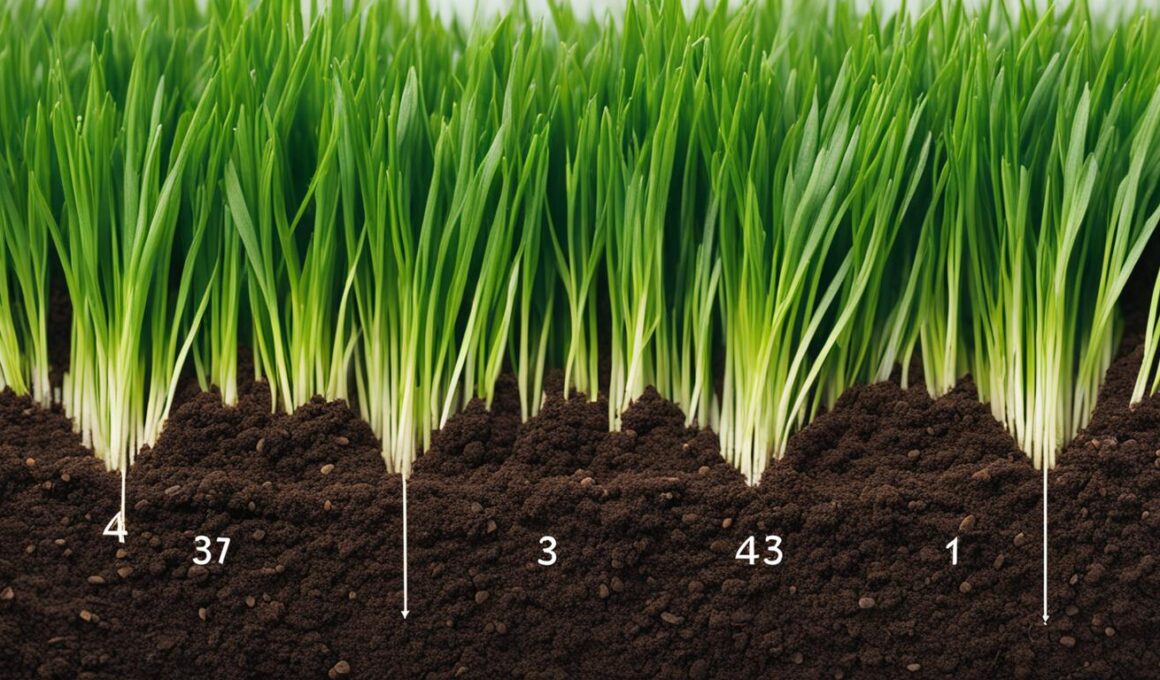Laying down grass seed at the right temperature is crucial for successful germination. Cool-season grasses, such as Jonathan Green Black Beauty, thrive in temperatures between 60 and 75 degrees Fahrenheit, with soil temperatures between 50 and 65 degrees Fahrenheit being ideal for seed germination. If the soil temperature is lower than 50 degrees, the seeds will remain dormant and not germinate. Soil preparation and the use of quality grass seed products, such as Jonathan Green’s Black Beauty, can help ensure optimal germination and the growth of a lush, healthy lawn.
Choosing the Right Products for Grass Seed Germination
Proper soil preparation is essential for successful grass seed germination. Before laying down the seed, it is important to check the pH of the soil. The ideal pH range for grass seed germination is between 6.2 and 7. You can easily test the pH of your soil using a pH testing kit available at most garden centers. If the pH is too low, there are products available, such as Jonathan Green’s MAG-I-CAL, that can quickly raise the pH of the soil and create a more favorable environment for seed germination.
In addition to pH testing, soil should also be properly prepared to create the best conditions for seed germination. Loosening and aerating the soil promotes good drainage and allows for better root development. By using soil aerating products, you can ensure that the soil is not compacted and that the roots of your grass seedlings have room to grow. Jonathan Green’s Love Your Soil is a recommended product specifically designed to improve soil health and nutrient absorption, creating an ideal environment for seed germination. Apply the product according to the instructions on the packaging for best results.
When preparing your soil, it is important to follow the recommended guidelines for the specific grass seed products you are using. Different grass seed varieties may have different requirements for optimal germination. Always refer to the packaging or product instructions for detailed information on soil preparation and application.
By properly preparing your soil and using the right products, you can lay the foundation for successful grass seed germination, leading to a healthy and lush lawn.
How to Lay Down Grass Seed for Optimal Germination
Once the soil is properly prepared, it’s time to lay down the grass seed. Follow these steps to ensure the optimal germination of your grass seedlings:
- Spreading Grass Seed: Use a spreader to evenly distribute the grass seed over the soil. This will ensure that the seeds are spread out and have enough space to grow. Avoid clumping the seeds together as it may lead to uneven growth.
- Raking the Soil: After spreading the grass seed, lightly rake the soil and seeds. This will help to create good seed-to-soil contact, allowing the seeds to establish firm root systems. It will also prevent the seeds from being exposed on the surface.
- Fertilizing the Soil: Fertilize the soil to provide essential nutrients for the growing seedlings. Choose a high-quality fertilizer specifically formulated for grass seedlings. Follow the recommended application rate to avoid over-fertilization, which can harm the young plants.
- Watering Grass Seedlings: Keep the newly planted area damp, but not waterlogged, until the seedlings reach a height of at least two inches. Watering plays a crucial role in seed germination and initial growth. Ensure that the soil is consistently moist, but be careful not to drown the grass seedlings.
By following these steps, you will create an optimal environment for grass seed germination, resulting in the establishment of a healthy and beautiful lawn.
How Can I Ensure Optimal Temperature for Grass Seed Germination?
To ensure optimal temperature for grass seed germination, it is important to keep the soil consistently moist and at a temperature of around 60-75°F. This will provide the ideal conditions for the seeds to sprout and establish healthy root systems. Just like raspberry seeds explained, grass seeds also need specific conditions for successful germination.
Conclusion
Despite grass seed germination being most successful in warmer temperatures, there are ways to sow grass seed in colder conditions, including during winter. Certain grass seed varieties, such as Jonathan Green’s Winter Green Grass Seed, can germinate even in soil temperatures as low as 5 degrees Fahrenheit.
To ensure successful germination in cold weather, it is crucial to perform proper soil preparation, select suitable grass seed varieties, and follow recommended planting techniques. By testing and adjusting soil pH, loosening and aerating the soil, and using products like Jonathan Green’s MAG-I-CAL and Love Your Soil, you can create an environment conducive to seed germination.
Furthermore, dormant seeding can be done in extremely cold weather, allowing early preparation for winter lawn repair. By taking the necessary steps and choosing the right grass seed, you can overcome the challenges of cold weather and achieve a lush, full lawn.









